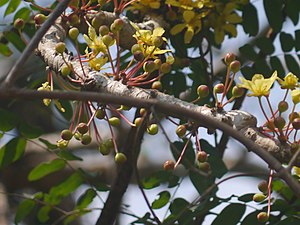Note: This is a project under development. The articles on this wiki are just being initiated and broadly incomplete. You can Help creating new pages.
Difference between revisions of "Dillenia pentagyna"
| Line 5: | Line 5: | ||
===Food=== | ===Food=== | ||
| − | Dillenia pentagyna can be used in Food. Flower buds and ripe fruits are eaten raw, thalamus is used in preparation of soft drinks. | + | Dillenia pentagyna can be used in Food. Flower buds and ripe fruits are eaten raw, thalamus is used in preparation of soft drinks<ref name="Forest foods of Western Ghat"/>. |
==Parts Used== | ==Parts Used== | ||
| Line 32: | Line 32: | ||
===Nutritional components=== | ===Nutritional components=== | ||
| − | Dillenia pentagyna Contains the Following nutritional components like - Vitamin-C; betulin, betulinic acid, β-sitosterol, Kaempferol, iso-rhamnetin and dillenetin; Calcium, Iron, Magnesium, Manganese, Phosphorus<ref name=" | + | Dillenia pentagyna Contains the Following nutritional components like - Vitamin-C; betulin, betulinic acid, β-sitosterol, Kaempferol, iso-rhamnetin and dillenetin; Calcium, Iron, Magnesium, Manganese, Phosphorus<ref name="Forest foods of Western Ghat"/>. |
==Habit== | ==Habit== | ||
| Line 57: | Line 57: | ||
==Cultivation == | ==Cultivation == | ||
| − | A plant of the moist, lowland tropics, where it is found at elevations up to 900 metres. Dillenia pentagyna is available through March-June<ref name=" | + | A plant of the moist, lowland tropics, where it is found at elevations up to 900 metres<ref name="How to plant/cultivate"/>. Dillenia pentagyna is available through March-June<ref name="Forest foods of Western Ghat"/>. |
==Commonly seen growing in areas== | ==Commonly seen growing in areas== | ||
| Line 76: | Line 76: | ||
<ref name="Leaf">[Morphology]</ref> | <ref name="Leaf">[Morphology]</ref> | ||
<ref name="How to plant/cultivate">[http://tropical.theferns.info/viewtropical.php?id=Dillenia+pentagyna Cultivation]</ref> | <ref name="How to plant/cultivate">[http://tropical.theferns.info/viewtropical.php?id=Dillenia+pentagyna Cultivation]</ref> | ||
| − | <ref name=" | + | <ref name="Forest foods of Western Ghat">"Forest food for Northern region of Western Ghats" by Dr. Mandar N. Datar and Dr. Anuradha S. Upadhye, Page No.66, Published by Maharashtra Association for the Cultivation of Science (MACS) Agharkar Research Institute, Gopal Ganesh Agarkar Road, Pune</ref> |
</references> | </references> | ||
Latest revision as of 12:39, 27 October 2021
Dillenia pentagyna is a deciduous tree growing up to 25 metres tall. The bole is usually rather crooked it can be free of branches for up to 12 metres and up to 100cm in diameter. The plant is gathered from the wild for a wide range of local uses including food, timber and fibre.
Contents
Uses
Scorpion bites, Cold, Cough, Anal fistula, Wounds, Diabetes, Diabetic carbuncle, Neuritis, Pleurisy, Pneumonia, Burning sensation.
Food
Dillenia pentagyna can be used in Food. Flower buds and ripe fruits are eaten raw, thalamus is used in preparation of soft drinks[1].
Parts Used
Chemical Composition
Common names
| Language | Common name |
|---|---|
| Kannada | |
| Hindi | |
| Malayalam | |
| Tamil | |
| Telugu | |
| Marathi | |
| Gujarathi | |
| Punjabi | |
| Kashmiri | |
| Sanskrit | |
| English |
Properties
Reference: Dravya - Substance, Rasa - Taste, Guna - Qualities, Veerya - Potency, Vipaka - Post-digesion effect, Karma - Pharmacological activity, Prabhava - Therepeutics.
Dravya
Rasa
Guna
Veerya
Vipaka
Karma
Prabhava
Nutritional components
Dillenia pentagyna Contains the Following nutritional components like - Vitamin-C; betulin, betulinic acid, β-sitosterol, Kaempferol, iso-rhamnetin and dillenetin; Calcium, Iron, Magnesium, Manganese, Phosphorus[1].
Habit
Identification
Leaf
| Kind | Shape | Feature |
|---|---|---|
Flower
| Type | Size | Color and composition | Stamen | More information |
|---|---|---|---|---|
| {{{5}}} |
Fruit
| Type | Size | Mass | Appearance | Seeds | More information |
|---|---|---|---|---|---|
Other features
List of Ayurvedic medicine in which the herb is used
Where to get the saplings
Mode of Propagation
Cultivation
A plant of the moist, lowland tropics, where it is found at elevations up to 900 metres[4]. Dillenia pentagyna is available through March-June[1].
Commonly seen growing in areas
Dense primary forests, Fire-savannahs, Open places in foothills, Shorea robusta woodland.
Photo Gallery
References
- ↑ 1.0 1.1 1.2 "Forest food for Northern region of Western Ghats" by Dr. Mandar N. Datar and Dr. Anuradha S. Upadhye, Page No.66, Published by Maharashtra Association for the Cultivation of Science (MACS) Agharkar Research Institute, Gopal Ganesh Agarkar Road, Pune
- ↑ [Chemistry]
- ↑ [Morphology]
- ↑ Cultivation
External Links
- Ayurvedic Herbs known to be helpful to treat Scorpion bites
- Ayurvedic Herbs known to be helpful to treat Cold
- Ayurvedic Herbs known to be helpful to treat Cough
- Ayurvedic Herbs known to be helpful to treat Anal fistula
- Ayurvedic Herbs known to be helpful to treat Wounds
- Ayurvedic Herbs known to be helpful to treat Diabetes
- Ayurvedic Herbs known to be helpful to treat Diabetic carbuncle
- Ayurvedic Herbs known to be helpful to treat Neuritis
- Ayurvedic Herbs known to be helpful to treat Pleurisy
- Ayurvedic Herbs known to be helpful to treat Pneumonia
- Ayurvedic Herbs known to be helpful to treat Burning sensation
- Herbs with Flower buds used in medicine
- Herbs with Fruits used in medicine
- Habit - Deciduous tree
- Index of Plants which can be propagated by Seeds
- Herbs that are commonly seen in the region of Dense primary forests
- Herbs that are commonly seen in the region of Fire-savannahs
- Herbs that are commonly seen in the region of Open places in foothills
- Herbs that are commonly seen in the region of Shorea robusta woodland
- Herbs
- Pages without herbs images





